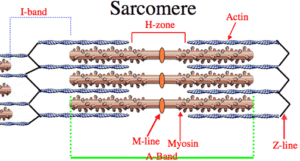Welcome again! Apropos of an earlier blog [Nov 19, 2022 THE BENEFITS OF MUSCULAR HEALTH], I have posted a photo above that we can probably ALL relate to!!
Clearly not the best head position for a long phone conversation and one that will likely lead to a stiff neck! So, as promised in that prior blog, I now present specifics regarding the development of the un-healthy muscle tissue patho-physiology of ischemia (AKA muscle knots and trigger-points), which leads to muscle stiffness, and worse, pains and increased risk to muscle injury.
My intent with these blog entries is to help everyone have a working knowledge of what our bodies need for good health and how simple and easy it is to provide that for ourselves. I also wish to give solutions for what we can do for times when pain or limited function do arise. So, to now further the understanding of this soft tissue ischemia, let’s add some detail, and explore ways that we overly tax our muscles, so that we can make decisions and take actions to prevent it from happening, and also to treat when it does occur.
Remember from before that muscles have only two states, ON or OFF, and that normal (healthy) muscles have an immediate relaxation response to the motor nerve signal going off, whereas knotted muscle tissue (ischemic) don’t. They have lost some of the ability to relax thereby creating the potential for premature fatigue and increased risk to injury (basically because they stay tight all the time). Some other important properties of ischemia are: (1) it is a result of a neurologic reflex, is not a conscious command, so we don’t know it’s occurring; (2) once developed the body does not have an “un-do” button for it; (3) no muscle ischemia exists at birth, yet small amounts can develop early in childhood, yet often none is actually noticed until early adulthood or later; and (4) ischemic tissue is difficult to notice because, the initial onset, usually a result of a defensive or protective response, is small, but unfortunately grows incipiently thereafter and to significant proportions. The way ischemia is usually finally noticed is an increase in stiffness and/or reduced range-of-motion (ROM), or worse by eliciting pain, or being causal to a soft-tissue injury.
When I read the above, I have an immediate interest in learning more about ischemia, so let’s dive in to a quick simplified story. My use of specific physiologic names and functions in this story is to provide easy handles for searches in the literature should more explanation be desired, so please just read past them if they seem to overly complicate the story. Also, see the diagrammatic image imbedded below for a visual description of many of these labels.
Now for the story (this is not the only process ischemic muscle tissue forms, yet is a very common one) —
Muscle fibers contract via motor nerve signal and this contraction is a result of mitochondria creating ATP from proteins causing the actin/myosin filaments within the sarcomere to draw together. Because of the metabolic process involved, there is resultant metabolic waste generated. Blood flow through muscle tissue has the dual function of bringing in nutrients (oxygen/proteins), and removing waste. Muscle metabolism can be aerobic and produce CO2 waste or anaerobic and produce lactic acid waste, and this is somewhat dependent on muscle type (type I or type II, etc) and on what activity is performed. Generally speaking, sustained and prolonged muscle contraction can change the metabolism from aerobic to anaerobic generating the more toxic lactic acid. Sufficient accumulation of toxic anaerobic wastes can trigger the sensory nerves to send a signal request to the spinal cord to shut the muscle down. The spinal cord has a reflex reply, that does not involve the brain, and as muscles are digital in nature (ON/OFF), the motor nerve’s only option to shut the muscle down is to send the ‘ON’ and the muscle thereby holds the contraction (basically shutting down by becoming in-operative). This results in further anaerobic wastes to accumulate, and now an endless “neurologic-reflex-arc” cycle is established which the body has no mechanism to un-do directly. I know that’s a mouthful, so just pause and read it slowly again, and here is a perhaps helpful summary statement: sustained muscle contraction causes build-up of toxic wastes causing a reflex to forever contract a given muscle fiber via the established “neurologic-reflex-arc”.
Sounds really bad, yet understand that this happens only on a micro-scale. There are many-many sarcomeres inside one tiny myofibril, and many-many myofibrils make up individual muscle fibers, and many-many muscle fibers make up one muscle cell, and many-many muscle cells make up a muscle (as we know them). So the actions of a single sarcomere can be of extremely small consequence. Yet over time it will grow to include more myofibrils, and that initial (once insignificant) ischemic tissue will become more and in an incipient fashion soon grow to a significant muscle dysfunction. And now the muscle knot and the trigger-point is born, along with the associated pain, twitch response, numbness, and other physical symptoms.
Remember that the causal factor is the sustained muscle contraction. In contrast to this sustained muscle contraction, which is problematic, the cyclical muscle contraction from exercise is very beneficial to muscle health. Our job then is to use our muscles in helpful ways, in ways that the last few blogs have indicated, and in ways that I will further explain in future blogs.
Of course we can’t get it right every time, and ischemic muscle will develop, so it is good to know what to do about it. There are many solutions, both in the self-help and in the professional therapy worlds. At Day to Day Healing, the most effective therapy offered is Neuromuscular Therapy, or NMT. Come make an appointment and check it out!
And I invite you to tune back in again for future blogs for more on how we can be the healthy-est US!
Finally, now back to the photo above, who even does this anymore?! We all have ear-buds now. And that’s a very good thing. Yet this used to be very common, and was the cause of many a stiff neck.
Here is the diagram illustrating much of the physiologic vocabulary used above.
SARCOMERE UNIT SCHEMATIC DIAGRAM —

